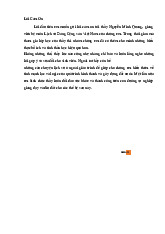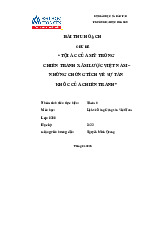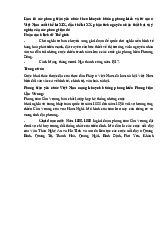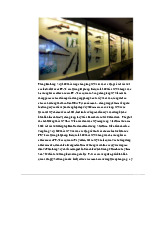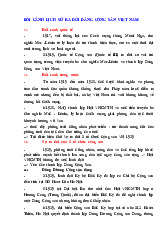



















Preview text:
Ministry of Education and Training
HOA SEN UNIVERSITY SCHOOL
Department Logistic – International commerce Report Subject: Import & Warehouse & Class code: WH 205DE01-0100 Semester: 2233 Group: 4 Name MSSV Le Duc Nguyen Khoi 2190808 Le Duc Nguyen Khoa 22011156 Nguyen Tuan Minh 22003716 Nguyen Tan Bao Khang TP.HCM, 22 May 2023 Years Teamwork summary Team member’s name Work Assigment Level of contribution Le Duc Nguyen Khoa Analysis ABC model, 100% stocktaking,EOQ. Warehouse Activity. Le Duc Nguyen Khoi Inbound warehouse. 100% Content synthesis. Nguyen Tuan Minh Outbound warehouse. 100% Do ppt Nguyen Tan Bao Khang Overal DHL company 100% Table of Contents
THANKS................................................................................................................................................4
PART 1 : DHL COMPANY’S WAREHOUSE MANAGEMENT:........................................................5 1.1.
Overall DHL’s company:............................................................................................................5 1.2.
Location Warehouse in VietNam:...............................................................................................7 1.3.
Network of DHL WAREHOUSE IN THE WORLD.................................................................12
1.4. Company business update:.............................................................................................................13
Part 2: DHL’S WAREHOUSE MANAGEMENT:...............................................................................15
2.1. WAREHOUSE CONSTRUCTION:..............................................................................................15
2.2) WAREHOUSE ACTIVITIES........................................................................................................31
2.3. STOCKTAKING:...........................................................................................................................50
Recommendation DHL Warehouse:......................................................................................................51
PART 3: Conclusion.............................................................................................................................52
Reference..............................................................................................................................................53 THANKS
Group 4 report is a report contributed and completed by all members of the group. First
of all, our team would like to express our deep gratitude to the lecturer in charge of
WareHouse, Ms. Pham Le Dung - Lecturer of Hoa Sen University. She accompanied
us throughout the learning process and enthusiastically taught practical lessons. The
necessary knowledge was always enthusiastically shared by her when we had
difficulties. During the time of writing, it is difficult to avoid mistakes, we hope to
receive your suggestions to improve our knowledge and writing skills better. Sincere thanks to the team!
PART 1 : DHL COMPANY’S WAREHOUSE MANAGEMENT: 1.1. Overall DHL’s company:
Picture 1: DHL’S COMPANY
The company was founded in 1969 by Adrian Dalsey, Larry Hillblom, and
Robert Lynn; and the initials D, H & L of the founders are used to name the company
DHL Express International. DHL's global headquarters are located in Bonn, Germany
and London, UK (Exel plc). The Americas (including US) headquarters is located in
Plantation, Florida, while the Asia-Pacific headquarters is in Singapore.
Picture 2: History of DHL COMPANY
1.2. Location Warehouse in VietNam: Pictures: Service Areas in DHL
In Vietnam, DHL has 2 largest distribution warehouses in Ho Chi Minh City:
DHL HCM South Service Center such as : Tan Uyen Town, Binh Duong City , Tan
Dinh (Dau Tieng Town, Binh Duong City ) , My Phuoc ( Ben Cat Town ) , VSIP II ,
Thu Dau Mot ( DHL BINH DUONG SERVICE CENTREL ).
DHL HCM North Service Center such as : Kim Ma ( Ba Dinh Town, Ha Noi city ),
Vinhome Westpoint ( Nam Tu Lien district),..... .
Pictures: Location DHL’S WAREHOUSE IN THE WORLD
STAFF is working in DHL WAREHOUSE :
PICTURES: DHL’s warehouse in Binh Duong province
More than 12 Certified international specialists,08 vehicles and 6 routes
Pictures: Staff in DHL WAREHOUSE
Everyday, Staff check the cargoes from ordering buyer. With 500 shipments delivery and pickup per day
Staff check the order the cargoes by mail. The speed of 30 min earlier delivery and latest pickup cut-off
After the goods have been packed. Staff will bring the cargoes and they will loading
the van. They spent 30 min earlier & lastest pickup cut off.
1.3. Network of DHL WAREHOUSE IN THE WORLD
More than 395,000 employees in more than 220 countries and territories around the
world, we reach more people than ever before.
Pictures: DHL Express of Network 1.4. Company business update:
Pictures: DHL EXPRESS MARKET IN 2021
Nguồn: 2023 BUSINESS PROFILE | DEUTSCHE POST DHL GROUP | MAY 2023 In Americas market:
FedEx,Incl,TNT > UPS > DHL In Europe market :
DHL > UPS > FedEx,Incl,TNT. In Asia Pacific market:
DHL> FedEx,Incl,TNT> UPS.
Pictures: Speed of the growth DHL in Germany in 2012-2022 Through the chart:
In 2020-2021, Parcel Germany volume is the largest about 15%, 13%.
2013,2014,2018, Parcel Germany volume is equal 7% .
In 2022, Parcel Germany volume is smaller about -8%.
DHL provide more 40% about Parcel Market Share, more 130 million about Parcel
Business customers, 11,300 Parcel Lockers.
Part 2: DHL’S WAREHOUSE MANAGEMENT: 2.1. WAREHOUSE CONSTRUCTION: WAREHOUSE MODEL: 2.1.1. Cross docking:
Pictures: DHL’s cross docking
DHL’s company have 64 dock doors to handle all of our inbound and outbound
truck. 95 trailers,2000 trucks come in and out on a daily basis pallet are offloaded and
the receiver verifies the shipper’s Bill off Landing
2.1.2. DHL’s Bonded Warehouse:
Pictures: DHL’S Bonded Warehouse
DHL invest a brand new 25,000 sq m hub in Segro Park Coventry Gateway, located
south of Coventry Airport. DHL will also feature secure bonded storage and customs
capabilities to support international e-commerce, a 48-door cross-dock facility and
state-of-the-art mechanisation, allowing automatic sortation of mixed-sized and weight
items through high-speed sortation equipment.
Pictures: DHL Toyoko Distribution center
DHL Tokyo Distribution Center (TDC) is currently situated, the new DHL Express
Tokyo Gateway is accessible from the Narita International Airport, Haneda Airport,
and Tokyo’s business districts. The new Osaka Distribution Center will increase
shipment processing capacity by more than 50%.
2.1.2. Warehouse Management System ( WMS ): 2.1.2.1. Internet of Things:
Pictures: DHL is using Internet of Things
The internet of things is a technology that allows us to add a device to an inert object
(for example: vehicles, plant electronic systems, roofs, lighting, etc.). IoT measure
environmental parameters, generate associated data and transmit them through a communications network.
The Internet of Things (IoT) has made full supply chain transparency - shipment
visibility, asset tracking, and condition monitoring - more possible than ever. As
network telecommunication systems speed up and expand reach, sensors are becoming
increasingly more affordable, thus making the potential for realizing new operational
efficiencies through a dedicated IoT strategy boundless.
Shipment monitoring for security and loss prevention:
Pictures: Prevent loss of goods
Iot can now monitor items as they move around a warehouse or distribution center as
well as across the entire supply chain.
Devices using GPS technology have been around for a long time, but it’s only recently
that they have the capabilities to add real value to logistics. Small sizes, long battery
lives, and strong signal strengths have made them a perfect solution for quality control
and loss prevention in small package shipping. Today’s devices come in all shapes and
sizes and can detect temperature, humidity, light, vibrations, etc.
Picture : Cold chain monitoring
IoT device now keeps track of the temperature
Covid-19 pandemic has put IoT to the test – and it passed. BioNTech announced its
vaccine needed to be transported at -70°C, it was up to logistics companies to develop
solutions to provide end-to-end visibility
IoT devices record and report conditions based on customer requirements, with the system flagging deviations detected.
Picture: Facility condition monitoring
Monitoring environmental conditions: Monitoring a facility was a manual and time-
consuming process. IoT devices are now connected using low-powered wide-area
networks (LPWANs), transmitting information in real-time to a central platform and the customer.
